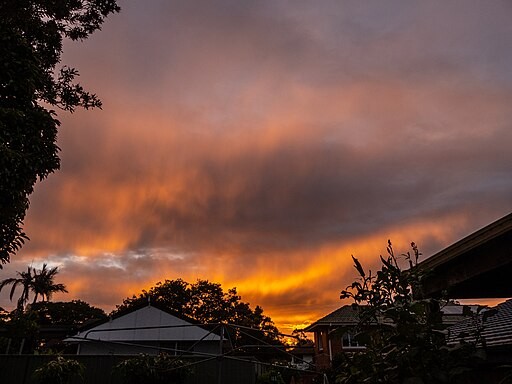Have you ever looked at the sky and seen streaks of snow or rain falling from the cloud but never reaching the ground? Similar cases happen when radar shows what looks like rain, but nothing hits the ground. This phenomenon is a type of weather event known as virga.

(Photo: Wikimedia Commons/ John Robert McPherson)
What is Virga?
The National Weather Services define virga as streaks or wisps of precipitation that fall from a cloud but evaporate before reaching the ground.
It is generally seen as fussy bits that extend from the bottom of storm clouds as a system starts to overspread the area.
Virga rain is more likely to happen in valleys than in mountains. One reason is that the ground is simply farther away from the clouds, so there is more air for the rain to fall through. Another reason is that mountains can force more rain to fall through orographic forcing. The mountains essentially force the air to go up and over, cooling and condensing the moisture in the air and causing more precipitation to fall.
This phenomenon can occur at any time of the year in the form of rain or snow. It can also occur before a microburst event, where a sudden downpour of rain builds up from the entrainment of dry air throughout the mid-levels of the atmosphere.
As the virga continues, evaporation leads to two things. First, it releases more moisture back into the air, and then it cools the air in a process called evaporative cooling. As the air becomes wetter and cooler, the relative humidity begins to rise to the point where it can support rain.
Virga can confuse meteorologists and the public. As the radar beam increases in height away from the radar site, it detects the signal of rain above the surface. As a result, signatures appear on the radar. Virga can be deceiving since it displays what looks like steady fall rain when it is actually not.
For this reason, meteorologists must consistently check observations at the surface to see if the rain that appears on the radar is reaching the ground. If the temperature is too far away from the dew point, the air could be too dry and evaporate before reaching the surface.
READ ALSO: Love that Smell After the Rain? Here's What You Need to Know About 'Petrichor'
How Does Virga Form?
Virga is produced when precipitation falls from high clouds into arid air and high temperatures below. This is why virga is commonly observed across the desert region of the Western US, which is prone to both low humidity and high temperatures.
This type of precipitation happens when rain falls through a specially dry part of the atmosphere that saturates from the upper atmosphere down to the surface. As the liquid raindrops or ice crystals hit the warm, dry air, they absorb high levels of heat energy, which energizes the movement of their water molecules. This transforms the precipitation straight into water vapor or sublimation.
As more and more precipitation evaporates into the air, the air becomes more moist. If the precipitation is light, it can take several hours before the air saturates. As the air saturates first aloft, then down to the surface, a "moist pathway" is carved out, causing the precipitation to follow to the surface as rain or snow.
RELATED ARTICLE: Can You Really Smell When It's About to Rain? Scientists Now Know Why
Check out more news and information on Precipitation in Science Times.

![Extinct Giant Salmon Had Tusk-Like Spikes Protruding Out of Its Snout That Can Easily Kill Shark, Other Large Marine Animals [Study]](https://1721181113.rsc.cdn77.org/data/thumbs/full/53304/89/56/50/40/extinct-giant-salmon-had-tusk-like-spikes-protruding-out-of-its-snout-that-can-easily-kill-shark-other-large-marine-animals-study.png)












